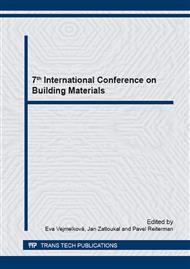[1]
A. Lacourt, M. Rinaldo, C. Gramond, S. Ducamp, Ilg. Soil, M. Goldberg, J. C. Piron, P. Brochard, Co-expsure to refractory ceramic fibers and asbestos and risk of pleural mesothelioma, European Respiratory Journal 44 (2014) 725-733.
DOI: 10.1183/09031936.00079814
Google Scholar
[2]
D. Koňáková, E. Vejmelková, V. Špedlová, K. Polozhiy, R. Černý, Cement Composites for High Temperature Applications, Advanced Materials Research 982 (2014) 154-158.
DOI: 10.4028/www.scientific.net/amr.982.154
Google Scholar
[3]
R. Stonis, I. Pundiene, V. Antonovič, M. Kligis, E. Spudilis, Study of the effect of replacing microsilica in heat-resistant concrete with additive based on metakaolin, Refractories and Industrial Ceramics, (2013).
DOI: 10.1007/s11148-013-9580-0
Google Scholar
[4]
M. Čáchová, D. Koňáková, E. Vejmelková, K. Polozhiy, R. Černý, Pore Distribution and Water Vapor Diffusion Parameters of Lime Plaster with Waste Brick Powder, Advanced Materials Research 1054 (2014) 205-208.
DOI: 10.4028/www.scientific.net/amr.1054.205
Google Scholar
[5]
M. Keppert, K. Polozhiy, Residual Strength of Thermally Loaded Mortars with Treated Municipal Solid Waste Incineration Fly Ash Used as Supplementary Cementitious Material, Advanced Materials Research 982 (2014) 114-118.
DOI: 10.4028/www.scientific.net/amr.982.114
Google Scholar
[6]
J. Krassowska, A. Lapko, 2012, The influence of basalt fibers on the shear and flexural capacity of reinforced concrete continuous beams, in: First International Conference for Ph.D. Students in Civil Engineering, Cluj-Napoca, Romania.
DOI: 10.17265/1934-7359/2013.07.002
Google Scholar
[7]
P. Reiterman, O. Holčapek, F. Vogel, M. Jogl, J. Koťátková, Fracture and Mechanical Properties of Fire Resistance Fibre Composites Containing Fine Ground Ceramic Powder, Advanced Material Research 897 (2014) 192-195.
DOI: 10.4028/www.scientific.net/amr.897.192
Google Scholar
[8]
S. Colombo, M. Vergani, M. Burman, Static and fatigue characterization of new basalt fibre reinforced composites. Composites Structures (2012) 1165-1174.
DOI: 10.1016/j.compstruct.2011.10.007
Google Scholar
[9]
S. Haoyang, J. Xu, Dynamic Compressive Behavior of Ceramic Fiber Reinforced Concrete Under Impact Load, Construction and Building Materials 45 (2013) 475-488.
DOI: 10.1016/j.conbuildmat.2013.04.008
Google Scholar
[10]
J. S. Szábo, J. Karger-Kocsis, O. Gryshchuk, T. Czigány, Effect of Fiber Surface Treatment on the Mechanical Response of Ceramic Fiber Material-Reinforced Interpenetrationg Vinyslester/Epoxy Resin, Composites Science and Technology (2004).
DOI: 10.1016/j.compscitech.2004.01.006
Google Scholar


